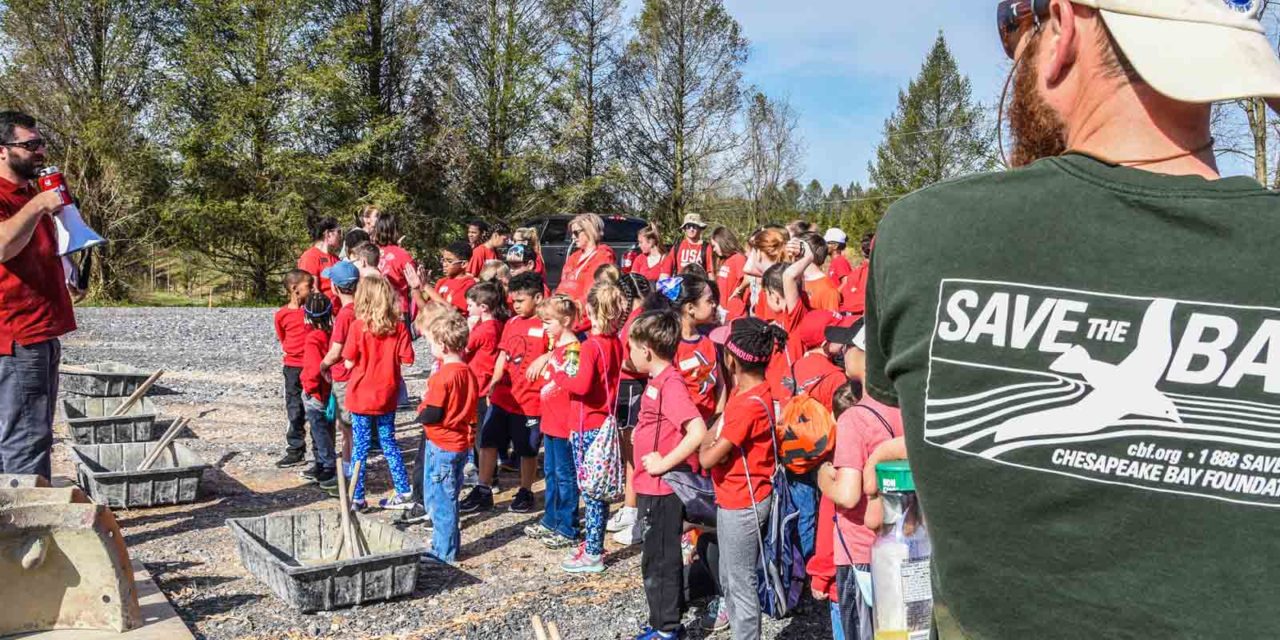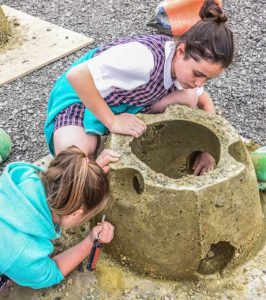
Olivia McDaniel (left) etches her initials into the side of the oyster ball while Jillian Wilson cleans off loose debris.
by Linda Esterson, photography by Phil Grout
Here’s a little-known fact: A single oyster can filter up to 50 gallons of water in a day.
So why is the Chesapeake Bay so cloudy?
“Oysters used to be able to filter the entire bay in two to three days, but now they can’t,” says Mike Wissel, vice president of the central region chapter of the Coastal Conservation Association (CCA). “There aren’t enough oysters left.”
Wissel estimates that the bay’s oyster population is only about 1 percent to 8 percent of its original size; the reason is overfishing. And that’s a major reason why the water quality has become degraded: Without the oyster filtration, runoff from farms and parking lots, and improper disposal of materials in sewers and streams that feed the bay has overwhelmed the estuary.
In an effort to combat this decline, Wissel led a group of conservation-minded fishermen in forming the CCA Central Region Chapter in 2014 — the national organization formed in Texas in 1977 — to “give the natural resource a voice.” The group is mainly concerned with restoring the population of fish and oysters, with the latter considered the keystone species of the bay.
Members launched the Living Reef Action Campaign, which operates with five key principles: restoring degraded habitat, creating new habitat, advancing the science of habitat restoration and conservation, fostering habitat stewardship and educating the local community about the value of conservation.
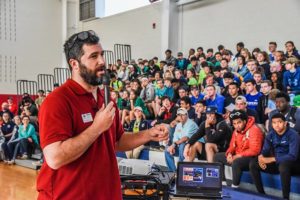
David Sikorski, executive director of the Coastal Conservation Association, describes the oyster reef ball project with an assembly of Gerstell Academy students who would soon be pitching in to make reef balls.
CCA’s educational outreach includes programming in local schools in which students build “reef balls” that serve as habitat for oysters and other life, including shrimp, crabs, fish and aquatic plants. Students also learn about oysters, including their history and ecological benefit, and also witness a dissection to learn about the parts of an oyster.
Gerstell Academy in Finksburg hosted CCA for a reef ball build as its Earth Day activity in late April. More than 400 students participated in the reef ball build, attended educational sessions and raced around campus on a natural scavenger hunt. It was CCA’s largest build to date.
“It’s great that our school is teaching about the environment and how to sustain it, especially because we’re in Maryland — so close to the bay,” says Kimberly Lapidario, a senior who will attend Salisbury University in the fall and hopes to enroll in marine biology classes at nearby University of Maryland Eastern Shore. “Earth Day is my favorite day of the year.”
Lapidario says the program aligns with one of the school’s leadership principles relating to respecting the divine nature of life in the universe.
“We’re here and taking time out of the school day, applying what we are learning and respecting nature and understanding it’s our turn,” she notes. “We’re the generation that is here to make the difference.”
 Many students echoed her sentiments.
Many students echoed her sentiments.
“The last time I was at the bay, it was super polluted and it made me sad,” says Jess Lyons, a senior who will study nursing at Hood College next fall. “Knowing we are doing something like this to help the population of the oysters grow is great.”
Fourth-grader Grace Heard also expressed her support. “I’m glad a lot of people still care about the bay and are concerned about wildlife. I think we should all try to keep it clean. A lot of people get food from the bay.”
“It’s cool that we are protecting oysters in the reservations because it helps all of the other animals in the ecosystem,” adds Taylor Yetta, a ninth-grader who excelled at cement mixing at the reef ball build. “I hope we set an example.”
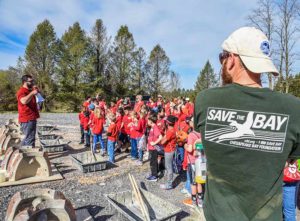
David Sikorski outlines the work for these Gerstell lower school students ready to mix concrete for the oyster reef project.
The oyster reef project is not Gerstell Academy’s first partnership with CCA. Each year, students take field trips to the bay as part of the science curriculum, according to Heather Snider, a lower- and middle-school science teacher who was one of the organizers of the day’s activities.
Public schools in Carroll County also partner with CCA as an extension to fourth-grade units that make connections to the Chesapeake Bay, “Interdependent Relationships and Ecosystems” and “Processes That Shape the Earth.” The reef ball program is a natural extension, says Bryan Shumaker, STEM coordinator for Carroll County public schools. About eight county schools participate in the program each year, totaling about 2,000 over the three years of the partnership.
“It’s authentic learning,” Shumaker said. “It puts kids in a situation where they are applying what they are learning. It empowers them to know they can make a difference.”
Another CCA program has ties to Carroll County schools. Two high school students who were CCA members heard a speaker talk about recycling oyster shells and created a program to collect shells from county restaurants to be used as substrate in which oysters to grow. CCA has also hosted happy hour events and oyster-themed dinners to spread awareness. In addition, Westminster’s annual Oyster Stroll was conceived and is held each spring to spread awareness within the community about the degradation of the bay and the need to improve public marine resources.
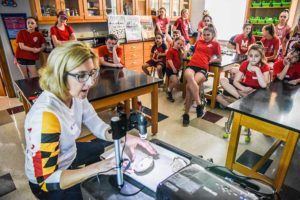
Kelly Wiesel with the Coastal Conservation Association lectures to students about the anatomy of an oyster.
Wissel knows the programs are making a difference for life in the bay. While fishing last summer, he ventured about two miles from a reef sanctuary. There were no signs of life, no fish, no birds. Once he was near the reef, there was a flurry of activity.
“It’s creating life in the bay,” he says. “I don’t think it’s any coincidence.”
CCA will continue its work, hoping to spur even more growth.
“We need to give it a voice,” he continues. “If we don’t, it will be a wasted natural resource for generations to come.”
REEF BALLS: FAST FACTS
- Student groups assemble large, holey metal frames, fill them with inflated rubber balls and mix and pour concrete over top to form the actual structure.
- Once dried and separated, the cement reef balls are soaked in tubs for two weeks and baby oysters (known as spat) are introduced and ultimately attach to the hard surface.
- The 150-pound balls are transported to designated sanctuaries in the bay, and within six months are covered with oysters, up to 2,000 at once. After about three years the oysters can be harvested.
- CCA has deployed about 500 student-made reef balls in the Chesapeake, accommodating an estimated 4 million oysters, according to Mike Wissel, vice president of the Central Region Chapter of the CCA.
- The program works in conjunction with the Chesapeake Bay Foundation, which provides volunteers who work alongside CCA volunteers and staff,
and donations from companies like Lehigh Cement Co. and Stevenson University, which constructed the ball molds as part of a research study.

